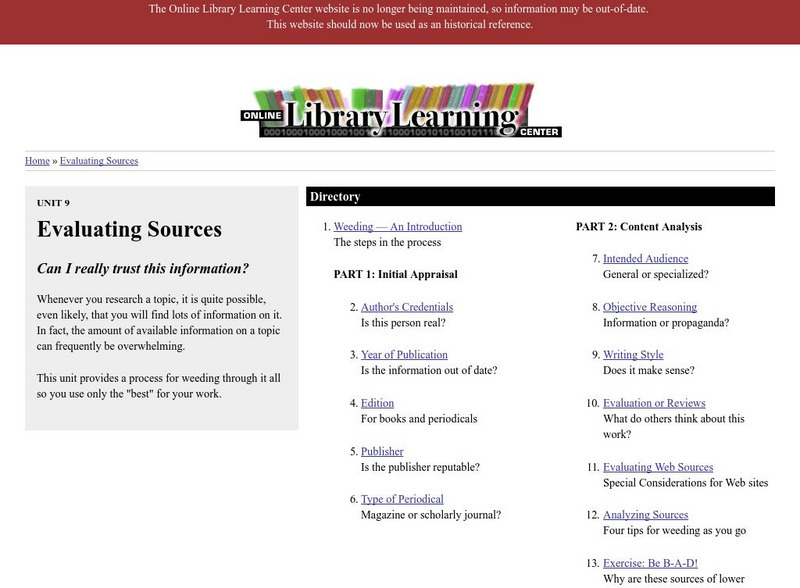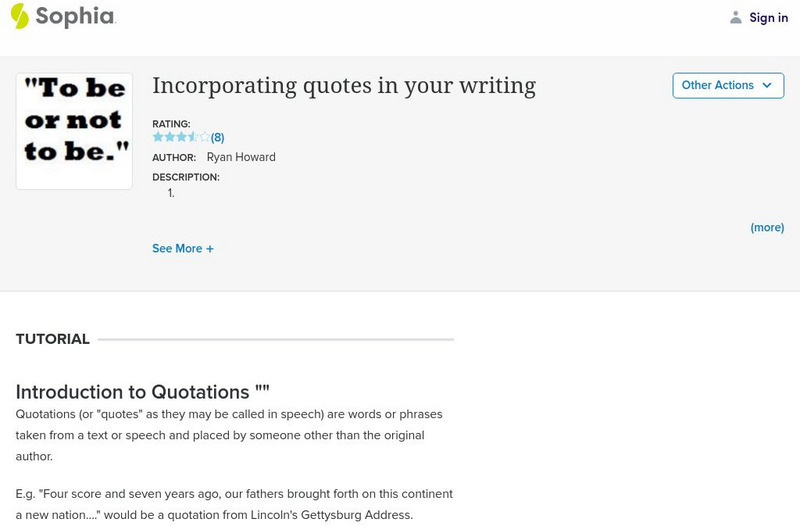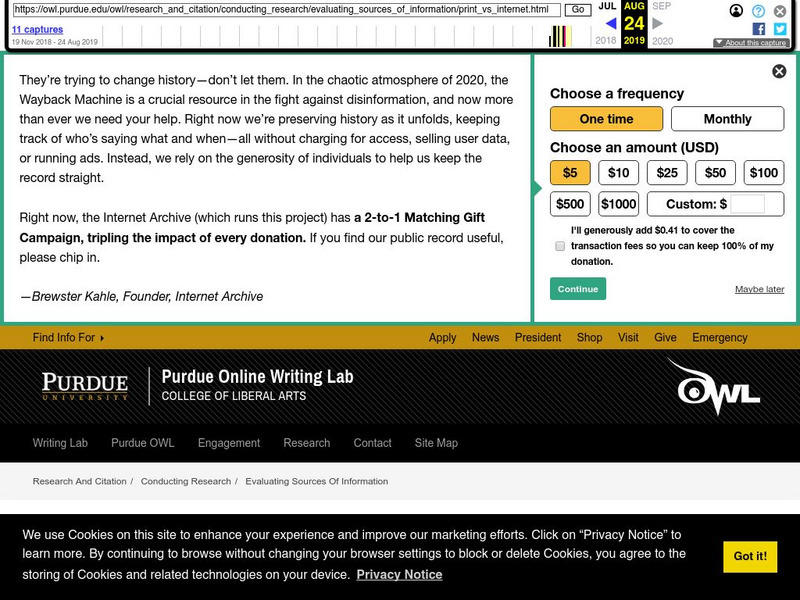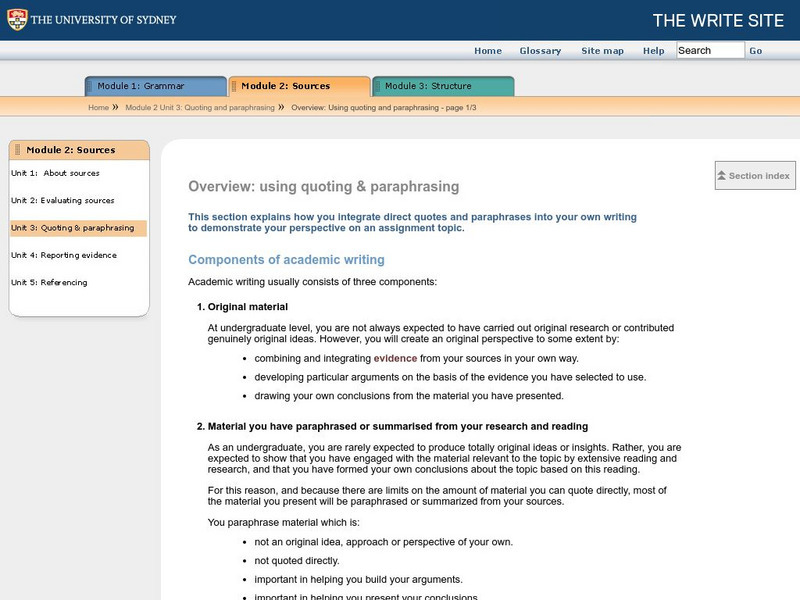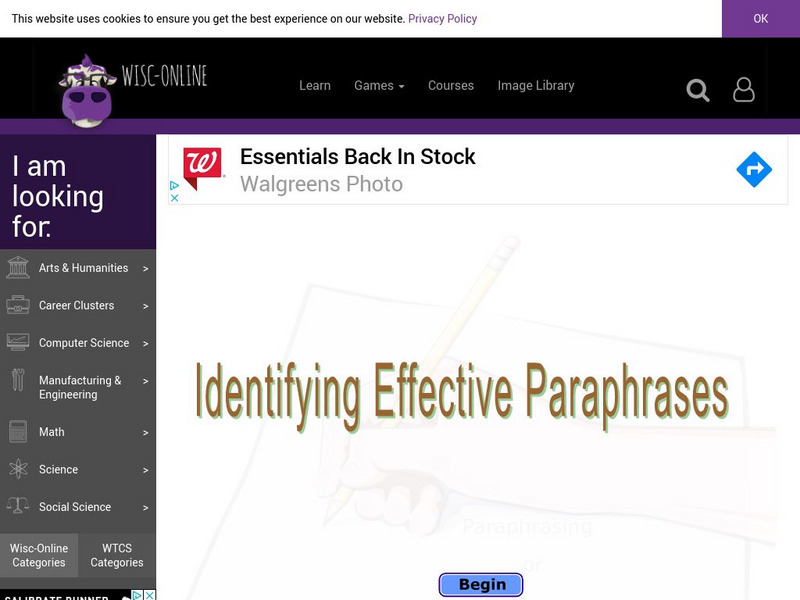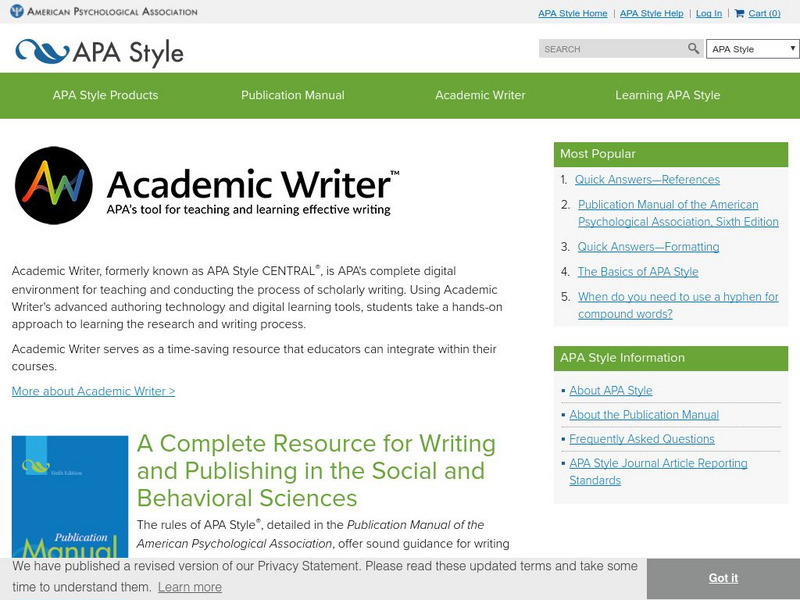Grammarly
Grammarly Handbook: Research and Documentation
An explanation of the importance of research and documentation and links to specific information for each.
Grammarly
Grammarly Handbook: Citations
This page focuses on the need for proper citation of all sources including in-text, footnotes, and endnotes in the appropiate style.
Grammarly
Grammarly Handbook: Asa (American Sociological Association)
This page explains the basics of the ASA citation style including in-text citations and the basics of bibliographic citations with examples. A link is provided to the ASA website for more information.
Other
Online Library Learning Center: Evaluating Sources
Use this "Weed and feed," approach to get only the best resources for your research project.
Online Writing Lab at Purdue University
Purdue University Owl: Quoting, Paraphrasing, and Summarizing
Provides guidance on the ways to quote, paraphrase, and summarize information. Gives various reasons for paraphrasing, summarizing, and quoting various sources.
ReadWriteThink
Read Write Think: Exploring Plagiarism, Copyright, and Paraphrasing
Contains plans for three lessons that deal with plagiarism, copyright law, and how to paraphrase correctly. In addition to objectives and standards, this instructional plan contains links to PDF handouts and sites used in the lessons as...
English Club
English Club: Plagiarism
This EnglishClub tutorial explains what plagiarism is, why students plagiarize assignments, and the serious repercussions of plagiarizing.
Tom Richey
Tom richey.net: Historical Writing: Writing Resources for Students
Resources for helping students to write historical essays. Includes a movie trailer to demonstrate the traits of a good introduction, tips for writing a paragraph, tips for formal writing, and guidelines for citing sources.
TES Global
Tes: Determining of Credibility of Online Sources
[Free Registration/Login Required] This free resource is a sheet that will help students assess the credibility of an online primary source or an online secondary source.
Sophia Learning
Sophia: Incorporating Quotes in Your Writing
Notes, a fourteen-slide presentation, and two videos teaching students how to incorporate and punctuate quotes into various sections of an essay and how to embed quotes within a paragraph.
Sophia Learning
Sophia: In Text Citations: Lesson 6
This lesson introduces in-text citations and how to embed them in text. It is 6 of 7 in the series titled "In-Text Citations." W.9-10.8 Sources
Cambridge Rindge & Latin School
Cambridge Rindge & Latin School: Making Source Cards
A great resource for putting together all of a student's possible sources onto note cards for later using in citing.
George Mason University
Gmu: Virginia Montecino: Criteria to Evaluate the Credibility of Www Resources
An easy-to-follow guide to assist in determining whether online resources are reliable and true. Find questions to ask while reviewing sources. CCSS.ELA-Literacy.CCRA.W.8 and CCSS.ELA-Literacy.CCRA.R.9
Online Writing Lab at Purdue University
Purdue University Owl: Evaluating Print vs. Internet Sources
Learn to look at different text features to determine whether a print or electronic source might be more effective. SL.9-10.2 eval & integrate sources
Online Writing Lab at Purdue University
Purdue University Owl: Types of Sources
A list and explanation of different types of print and online sources. W.11-12.8 Sources/Integrate/Cite
University of Toronto (Canada)
University of Toronto: Standard Documentation Formats
Documenting Internet resources is becoming standardized. You'll find some of the basics here, plus links to more detailed guidelines now included in respected academic style guides. L.9-10.3a Standard Format, W.11-12.6 Technology,...
Sophia Learning
Sophia: Summary and Paraphrase: Tutorial
In this slideshow tutorial, students are provided with notes that distinguish "summarizing" from "paraphrasing" content. Examples of effective summaries and paraphrases of text are provided. Then students have the opportunity to engage...
Other
Plagiarism: Teaching About Plagiarism
The best way to prevent plagiarism is to educate students on how to properly conduct research, cite, quote, and produce unique and original work. This site offers a series of video explaining plagiarism and ways to avoid it.
University of Sydney (Australia)
The Write Site: Overview: Using Quoting & Paraphrasing
This learning module explains the components of academic writing. The module includes the following topics: original material, paraphrased content, summarized information, and direct quotations.
Indiana University
Indiana University: Plagiarism
Uses examples to explain the right and wrong way to use reference material. Shows how a rewrite can still be plagiarism. Briefly discusses common knowledge and paraphrasing.
Wisc-Online
Wisc Online: Identifying Acceptable Paraphrases
This learning module defines paraphrasing and discusses how to paraphase, and then they identify acceptable paraphrases of source material.
Department of Defense
Do Dea: The Plagiarism Spectrum
The Plagiarism Spectrum identifies 10 types of plagiarism. View this chart which tags each type with an easy to remember digital moniker, definition, rank by severity, and score by frequency of appearance.
Library of Congress
Loc: How to Cite Digitized Primary Sources
Learn from the Library of Congress how to correctly cite the many electronic resources available in their collection. Films, legal documents, photographs, maps, sound recordings and other unusual cases are covered. Be sure you click on...
Other
Apa Style Central
Use this comprehensive resource to learn about APA style. Students and teachers can use this site as a springboard for any questions they may have concerning APA Style.



